外研高一必修3 Module 6 Old and New模块复习课件(58张)
文档属性
| 名称 | 外研高一必修3 Module 6 Old and New模块复习课件(58张) | 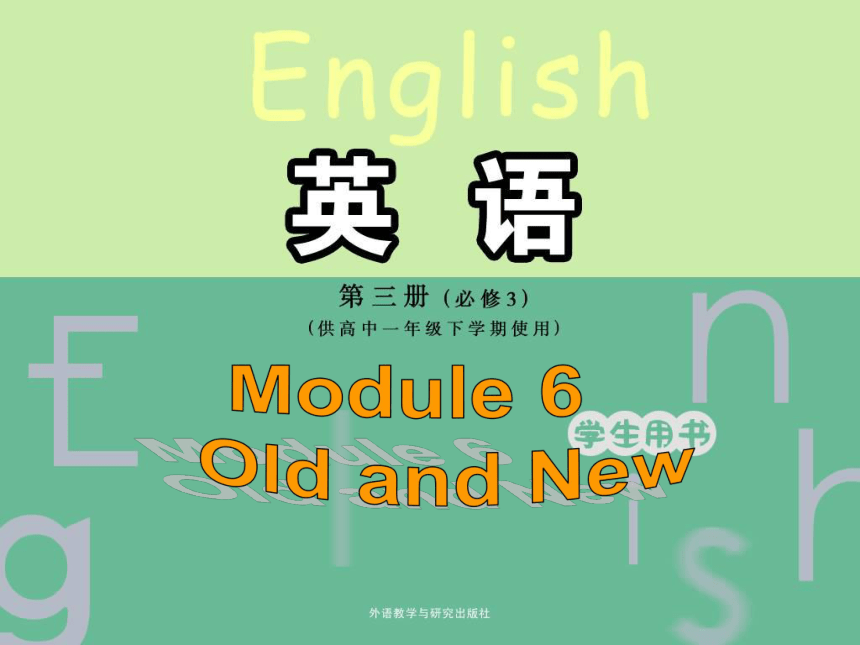 | |
| 格式 | zip | ||
| 文件大小 | 196.3KB | ||
| 资源类型 | 教案 | ||
| 版本资源 | 外研版 | ||
| 科目 | 英语 | ||
| 更新时间 | 2017-01-18 20:14:54 | ||
图片预览

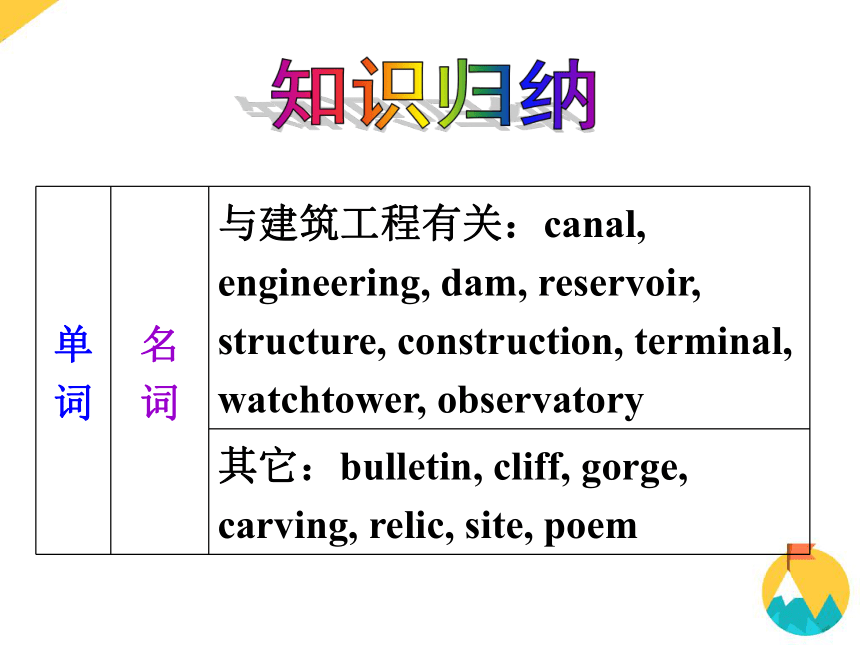
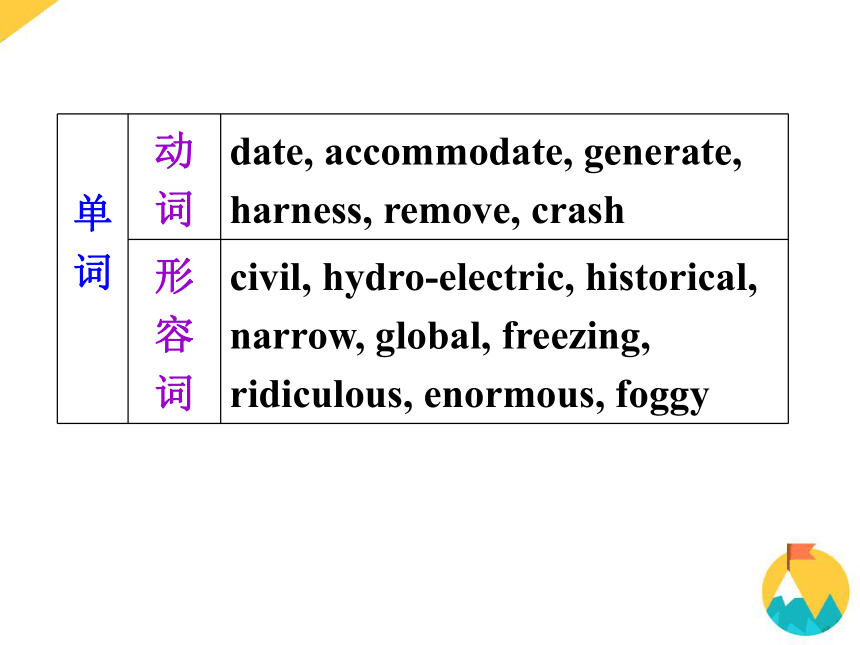

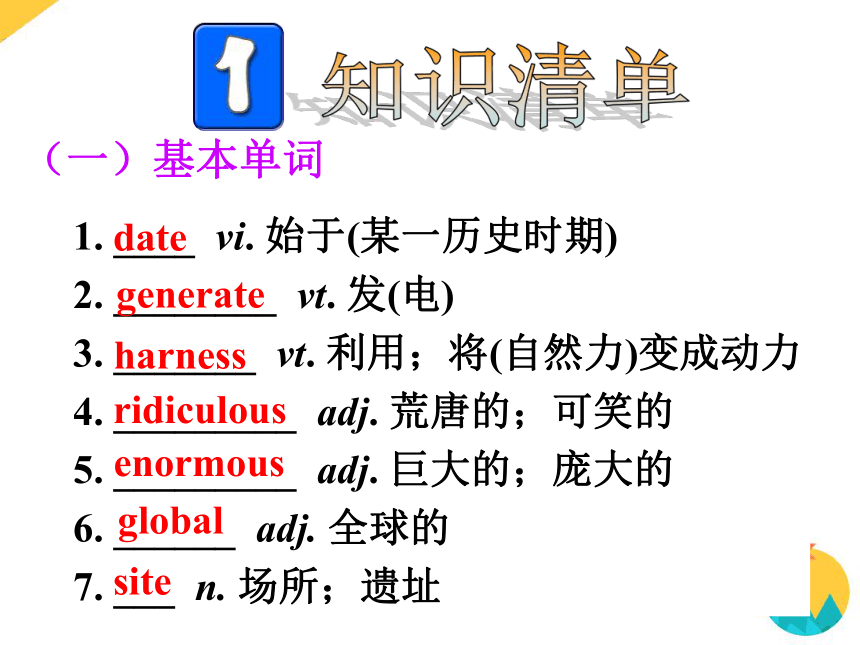

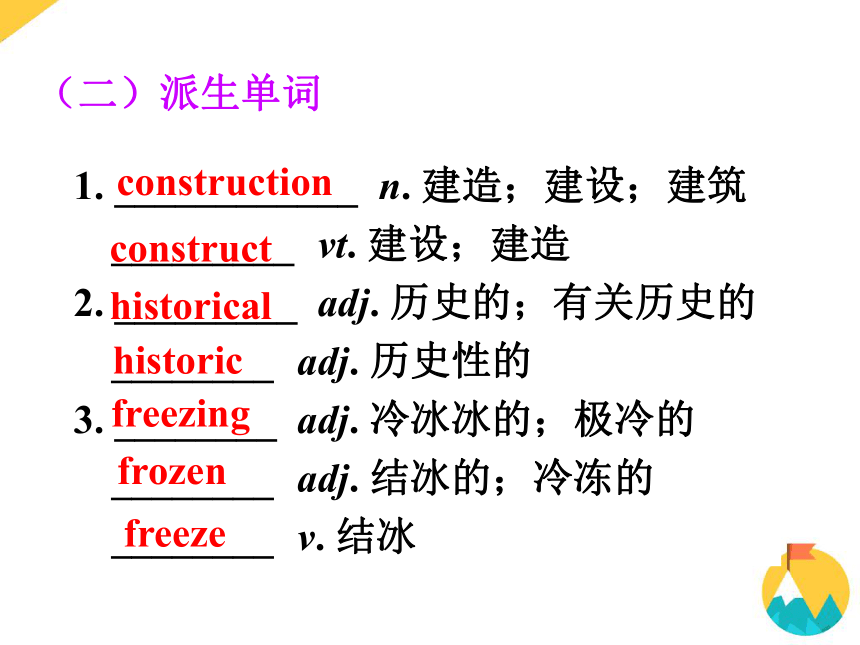


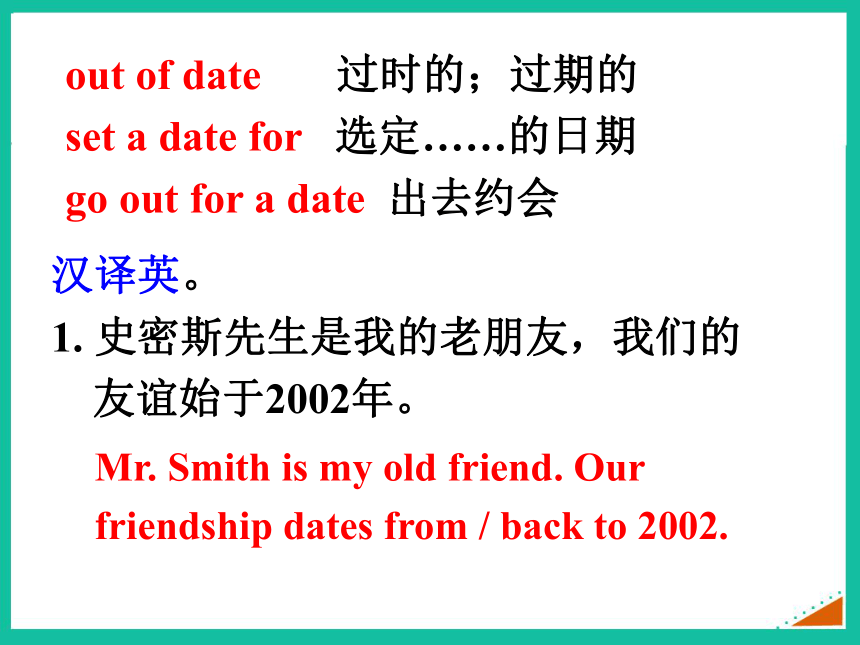

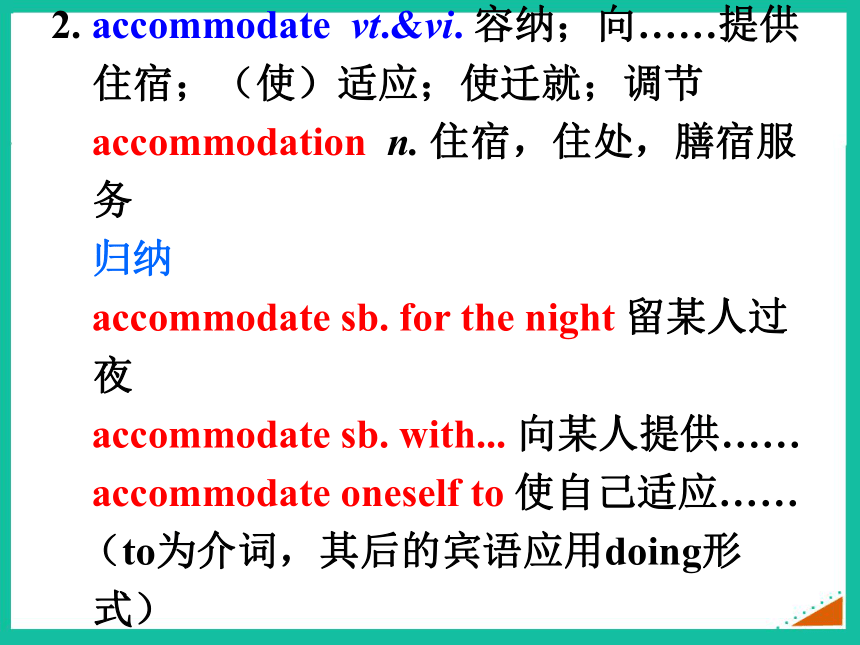
文档简介
课件58张PPT。Module 6
Old and New知识归纳 1. ____ vi. 始于(某一历史时期)
2. ________ vt. 发(电)
3. _______ vt. 利用;将(自然力)变成动力
4. _________ adj. 荒唐的;可笑的
5. _________ adj. 巨大的;庞大的
6. ______ adj. 全球的
7. ___ n. 场所;遗址知识清单(一)基本单词dategenerateharnessridiculousenormousglobalsite8. ____ adj. 民用的;国内的
9. ____ n. 悬崖;峭壁
10. ________ n. 建筑物;结构
11. ______ adj. 狭窄的
12. _____ n. 诗歌
13. ______ vt. 迁移;搬迁
14. _____ adj. 有浓雾的
15. _____ vi.(飞机)失事;坠毁civilcliffstructurenarrowpoemremovefoggycrash1. ____________ n. 建造;建设;建筑
_________ vt. 建设;建造
2. _________ adj. 历史的;有关历史的
________ adj. 历史性的
3. ________ adj. 冷冰冰的;极冷的
________ adj. 结冰的;冷冻的
________ v. 结冰constructionconstructhistoricalhistoricfreezingfrozenfreeze(二)派生单词1. 起源于
2. 阻止
3. 变成现实
4. 有意义,有道理
5. 结束,终止
6. 梦想
7. 凭借做某事
8. 过着幸福的生活
9. 等于;胜任(三)短语date fromhold backcome truemake sensebring an end todream ofby doinglive a happy lifebe equal to1. date n. 日期,年代;时代;约会
v. 加日期于;起始于;属于(某时期)
归纳
date from/ back to 始于;追溯到……(常用一般现在时,无被动和进行时态。句中有提示从过去某一时间往前,则用过去时。)核心要点(一)单词out of date 过时的;过期的
set a date for 选定……的日期
go out for a date 出去约会汉译英。
1. 史密斯先生是我的老朋友,我们的友谊始于2002年。Mr. Smith is my old friend. Our friendship dates from / back to 2002.2. 你的电脑系统早已过时了。
3. 在页面顶端写上今天的日期。Your computer system is already out of date.Write today’s date at the top of the page.2. accommodate vt.&vi. 容纳;向……提供住宿;(使)适应;使迁就;调节
accommodation n. 住宿,住处,膳宿服务
归纳
accommodate sb. for the night 留某人过夜
accommodate sb. with... 向某人提供……
accommodate oneself to 使自己适应……
(to为介词,其后的宾语应用doing形式)3. remove v. 移动;搬迁;除去;使离开
归纳
remove... from... 把……从……移开
remove sth. from some place to...
把某物从……搬迁到……
be removed from school
被开除,勒令退学
be removed from 与……远离根据括号内的汉语提示补全下列句子。
1. Sally ____________________ (摘下眼镜) and put it on the table.
2. As soon as the cake is done, _________ ______________ (把它从炉子里取出).
3. Our company ____________________ _______________ (从北京搬到了上海) last month.removed her glassesremove itremoved from Beijingfrom the oven???? to Shanghai辨析move与remove
move 指从一地到另一地的移动,移动某物的位置或改变某人的姿势,既是及物动词又是不及物动词。
remove “取消,去掉”,含有把不利的东西“除掉”的意思,强调完全放弃原来的地方而到达新的位置,有时相当于take away/ off;表示“迁居”时,二者均可。1. hold back 阻挡;控制(情绪、情感等);犹豫
拓展
hold down 压制,制止
hold off(雨等)暂时不下,推迟(某事)
hold on ?坚持;(电话)别挂
hold out? 伸出,提出,坚持(抵抗)
hold up? 举起,耽误(二)短语用适当的副词填空。
1. Sorry I’m late — I was held ____ at work.
2. His poor education is holding him ______.
3. The water won’t hold ______ much longer.
4. Mary often holds ______ from people who try to be friendly.
5. Tim hasn’t held ______ a job for more than a year.up????back?out?off?down2. make sense 有道理;讲得通
拓展
make sense of 了解……的意义,懂得
a sense of duty/ humor/ beauty/ direction
责任/幽默/审美/方向感
in no sense 绝不
come to one’s senses 恢复理性,苏醒
There is no sense in doing sth.
做某事没道理/没意义辨析make sense与make sense of
make sense “有意义;有道理;讲得通;可理解”,物作主语,无被动,用to引出人。
make sense of “弄懂;理解”,人作主语,可以用于被动语态,用of引出物。
注意:以上两个短语中,sense前不加冠词,也不能用复数形式。将下列句子翻译成汉语。
1. Can you make sense of this poem?
你看得懂这首诗吗?
2. She doesn’t talk much, but what she
says makes sense.
她不多讲话,但言之有理。 3. come true (梦想等) 变成现实
拓展
come about 发生
come out 出版或发表,开花
come over 过来,顺便来访
come across 遇见,巧遇
come along 一道去,进展
come back 回来,折回
come up 上升,上来,发芽辨析come true与realize
都可以表示实现。
come true 是不及物,不跟宾语,不用被动。
realize 及物动词,后面跟宾语或用被动语态。4. dream of 做梦;梦见;向往
拓展
1) dream 后面可接that从句。
e.g. He dreamed that he could go to
Beijing University for further study.
2) dream 可用作名词,表示“梦;梦
想”。
e.g. She dreamed a sweet dream.3) dream 的过去式、过去分词有两种形式:
dreamed, dreamed; dreamt, dreamt。
4) dream up=make up 设想出来;编造
wouldn’t dream of 不含有……想法
go to one’s dreams 进入梦乡5. bring an end to sth.=bring sth. to an end
结束;终止;停住
拓展
by the end of 到……结束时
bring… to an end 使终止
on end 连续地
come to an end (不及物动词短语)
结束;完毕
put an end to sth. 结束;消除
be at an end (=finish) 结束根据所给的英文释义及首字母,用其适
当形式完成下列句子。
a. c________:?of or relating to the citizens of a country
b. n________:?measuring only a small distance from one side to the other, especially in relation to the lengthExercisescivil ?narrow? c. h_________?: connected with the past
d. c__________:?the process of building things such as houses, bridges, roads, etc.?historical construction 选用方框内合适的短语并用其正确形式
填空(每个短语限用一次)。
1. My interest in stamp collecting ____________ my schooldays.
2. The dam was not strong enough to ___________ the flood waters.make sense, come true, bring an end to, hold back, date fromdates fromhold back?3. She couldn’t believe that her dream would ever __________.
4. She doesn’t talk much, but what she says ____________.
5. It’s hoped the talks may ______________ the violence.make sense, come true, bring an end to, hold back, date fromcome truemakes sense?bring an end to1. It took six years to build and cost US $20 billion.
它花费了6年时间建成,耗资200亿美元。
1) It takes sb. some time to do sth.
某人花费时间做某事
e.g. It took us a week to finish the
work.(三)句式2) it作形式主语的几种句型:
It+be+adj./n.+(for sb.) to do sth.
It+be+adj.+of sb. to do sth.
It+be+adj./n.+doing sth.
It+be+adj./n.+that-clause
It+be+p.p.+that-clause
It+seems/ appears+that-clause
It takes sb. some time to do sth.
It seems/ looks as if...e.g.
It’s important for us to learn English well.
It’s wise of you to make such a decision.
It’s a waste of time arguing further.
It’s dangerous playing with fire.
It was reported that a severe snowstorm hit that area last week.
It looks as if my parents treat me as a guest.
3) sb. spends time/ money on sth.
sb. spends time/ money (in) doing sth.
sb. pays money for sth.2. A temple is a place of great importance to Buddhists.
对佛教教徒来说,寺庙是个很重要的地方。
be+of+抽象名词:描述人或事物的特征,作表语、后置定语或宾语补足语。类型有:1) be+of+抽象名词,相当于这一名词的形 容词形式。如value, use, help, importance, difference等,这些名词前可用great, no, little, some, any, not much等修饰,表示不同程度。
e.g. The camel is of great help to the
Arab.
对阿拉伯人来说,骆驼很有帮助。2) be+of+size/ weight/ height/ age/ color/ opinion/ width/ length/ type, etc.,名词前一般加不定冠词或the same。这个结构中的名词没有相应的形容词形式。
e.g. The two boys are of the same
weight.
这两个男孩一样重。限制性定语从句与非限制性定语从句一、形式不同
限制性定语从句与主句之间不能用逗号隔开;非限制性定语从句与主句之间通常用逗号隔开。
e.g. Everyone who / that knew Jack liked him.
Liu Ying, who is our monitor, is kind and
always ready to help others. 语法 二、作用不同
限制性定语从句对先行词进行修饰和限制,如果去掉,主句的意思就会不完整、不明确或失去意义;非限制性定语从句对先行词进行补充说明,与主句的关系不十分密切,如果去掉,主句的意思仍然完整。
e.g. The woman (that / who / whom) you met
just now is my mother.
The students went to the hospital to see
Professor Nora, whom they respect greatly. 三、关系词用法不同
1.在限制性定语从句中,关系代词作宾语时
可以省略,而在非限制性定语从句中关系
词一律不能省略;
2.非限制性定语从句不能由that引导。
e.g. The education (which / that) my uncle
received added up to no more than two
years.
The dictionary, which my father bought
in Beijing, is very helpful to me. 四、关系代词指代不同
限制性定语从句的关系代词一般指代一个名词或代词;非限制性定语从句的关系代词则既可指代一个名词,也可以指代主句的部分或全部内容。
e.g. They tried to think of a plan by which
they could finish the task earlier.
This house, for which Mr. Smith paid
$150,000, is now worth $300,000.
He said he was busy, which was untrue. 用适当的关系词填空(关系词可省略时填适当的关系词或不填)。
I just read a book called Technostress, 1. ________ was written by Dr. Michelle Weil. Her co-author was Dr. Larry Rosen, 2. _____ is her husband and also a psychologist. According to the authors, everybody feels stressed about technology. Our mobile phones, 3. ________ we buy for emergencies (紧急情况), soon affect our personal life. which?who?which??Just because they can, people contact us at places 4. ________ we are relaxing. Another problem 5. _________________ we are facing is that we have to learn too much too fast. Technological changes, 6. ________ used to come one at a time, now overwhelm (淹没) us. Dr. Weil suggests that we read her latest book, to 7. ________ we can turn for help when dealing with technostress.where?that / which / 不填?whichwhich选用方框内合适的关系词填空(每词限用
一次)。
1. After the flooding, there were many people suffering in that area, ________ urgently needed clean water, medicine and shelter to survive.?when, where, why, who, whom, which, that, whosewho?巩固练习2. Amy’s fondest memory is of last year, ________ the club gave a tea party for her birthday.
3. The old town has narrow streets and
small houses _______ are built close to
each other.when, where, why, who, whom, which, that, whosewhen?that?4. That evening, ________ I will tell you more about later, I ended up working very late.?
5. I wish to thank Professor Smith, without ________ help I would never have got this far.when, where, why, who, whom, which, that, whosewhich?whose?6. I walked up to the top of the hill with my friends, ________ we enjoyed a splendid view of the lake.
7. She brought with her three friends, none of ________ I had ever met before.
8. Is this the reason ________ you are in favor of the program?when, where, why, who, whom, which, that, whosewhere?whom?why阅读下面材料,在空白处填入适当的内容(不多于3个单词)或括号内单词的正确形式。
?????? India’s national capital region, Delhi, is made up of a number of cities, which is why 1. ___ is sometimes known as the city of cities. In 1639, the Mughal Emperor Shah Jahan (1592-1666) built a walled city 2. ______ (call) Shahjahanabad. This served 3. _____ the capital of the Mughal Empire until 1857. it?called?as? Much of what is now known as Old Delhi with its winding narrow streets filled with 4. ______ (live) markets is Shahjahanabad. In 1911, a new capital for British Imperial India with 5. __________ (organize), open, wide streets was designed around the site of Shahjahanabad by architects Sir Edwin Lutyens (1869-1944) and Sir Herbert Baker (1862-1946), but construction didn’t begin until after the First World War. livelyorganizedThe result was New Delhi, which became the new capital of British Imperial India in 1931.
?????? Delhi is now 6. _____ enormous urban area with a population of some twenty-two million people. It is a mixture of the old and the new, overflowing with historical monuments, such as the Red Fort, named after the red sandstone from 7. ________ it was made, an? which?and home to the Mughal emperors for nearly 200 years after it was built in 1648, and examples of modern 8. ____________ (architect), such as the Lotus Temple, a flowerlike structure made up of free-standing marble petals, built in 1986 as a place of worship 9. _____ welcomes people of all religions. In Delhi, a visitor can be looking at a relic 10. ____ the past one minute and the next sitting in a smart modern cocktail bar or shopping in a busy modern mall.architecturethat?of根据汉语提示补全下列句子。
1. 21年后,卡尔想要拥有一座房子的梦想实现了。
After 21 years, Carl’s dream of owning a house has _________ .
2.?犯罪分子们浪费他们有限的精力拒捕是毫无意义的。
It does not __________ for criminals to waste their limited energy resisting arrest.come true??make sense 1. Though this kind of clothes are beginning to be _____, she was very happy to wear it.
A. out of date
B. up to date
C. old
D. bad
解析:尽管这种衣服不再开始流行,她仍乐
意穿着。out of date “过时的”。up to date“新
式的”。Ⅲ. 单项选择。2. The new apartment built a few months ago
is large enough to _____ over two hundred
people.
A. include B. provide
C. reside D. accommodate
解析:几个月前完工的这座新公寓大到可以容纳二百多人。accommodate “为……提供住宿,容纳”。include“包括”;provide “提供”,provide sb. with sth. 或provide sth. for sb.;reside “居住”。3. Despite the attacks we _____ the bridge
for 3 more days.
A. hold on
B. hold over
C. hold up
D. hold on to
解析:hold on “坚持,不挂断”,为不及物动词短语;hold over “推迟”;hold up “举起;耽误”。hold on to “抓住……不放手”。4. In a word, I don’t think what you said
_____ at all.
A. makes some sense
B. make any sense
C. makes sense
D. make sense
解析:总之一句话,我认为你说的一点道理也没有。make sense “有道理,讲得通”。what you said作主语,故谓语动词用第三人称单数形式。5. I’d always dreamt about owning my
own house, but I never thought it would
_____.
A. come up B. come out
C. come true D. come off
解析:come true “实现”;come up “发芽;上升”;come out “开花;出版”;come off “脱落;成功”。 豌豆作为食物很早以前就开始了。
2. 这家旅馆可供600位客人住宿。
3. 看到车祸,他吓呆了。翻译下列句子。The use of peas as food dates back to
very early time.This hotel can accommodate 600 guests.Seeing the car accident, he was frozen with terror.4. 听到她女儿成功了,她禁不住流下喜悦的泪水。
5. 我没明白他刚才说的话。
6. 你能告诉我事故是怎样发生的吗?
7. 这个建议对我来说没有什么用。 Hearing her daughter’s success, she could
not hold back tears of joy.What he said just now makes no sense to me.Can you tell me how the accident came about?This suggestion is of no use to me.
Old and New知识归纳 1. ____ vi. 始于(某一历史时期)
2. ________ vt. 发(电)
3. _______ vt. 利用;将(自然力)变成动力
4. _________ adj. 荒唐的;可笑的
5. _________ adj. 巨大的;庞大的
6. ______ adj. 全球的
7. ___ n. 场所;遗址知识清单(一)基本单词dategenerateharnessridiculousenormousglobalsite8. ____ adj. 民用的;国内的
9. ____ n. 悬崖;峭壁
10. ________ n. 建筑物;结构
11. ______ adj. 狭窄的
12. _____ n. 诗歌
13. ______ vt. 迁移;搬迁
14. _____ adj. 有浓雾的
15. _____ vi.(飞机)失事;坠毁civilcliffstructurenarrowpoemremovefoggycrash1. ____________ n. 建造;建设;建筑
_________ vt. 建设;建造
2. _________ adj. 历史的;有关历史的
________ adj. 历史性的
3. ________ adj. 冷冰冰的;极冷的
________ adj. 结冰的;冷冻的
________ v. 结冰constructionconstructhistoricalhistoricfreezingfrozenfreeze(二)派生单词1. 起源于
2. 阻止
3. 变成现实
4. 有意义,有道理
5. 结束,终止
6. 梦想
7. 凭借做某事
8. 过着幸福的生活
9. 等于;胜任(三)短语date fromhold backcome truemake sensebring an end todream ofby doinglive a happy lifebe equal to1. date n. 日期,年代;时代;约会
v. 加日期于;起始于;属于(某时期)
归纳
date from/ back to 始于;追溯到……(常用一般现在时,无被动和进行时态。句中有提示从过去某一时间往前,则用过去时。)核心要点(一)单词out of date 过时的;过期的
set a date for 选定……的日期
go out for a date 出去约会汉译英。
1. 史密斯先生是我的老朋友,我们的友谊始于2002年。Mr. Smith is my old friend. Our friendship dates from / back to 2002.2. 你的电脑系统早已过时了。
3. 在页面顶端写上今天的日期。Your computer system is already out of date.Write today’s date at the top of the page.2. accommodate vt.&vi. 容纳;向……提供住宿;(使)适应;使迁就;调节
accommodation n. 住宿,住处,膳宿服务
归纳
accommodate sb. for the night 留某人过夜
accommodate sb. with... 向某人提供……
accommodate oneself to 使自己适应……
(to为介词,其后的宾语应用doing形式)3. remove v. 移动;搬迁;除去;使离开
归纳
remove... from... 把……从……移开
remove sth. from some place to...
把某物从……搬迁到……
be removed from school
被开除,勒令退学
be removed from 与……远离根据括号内的汉语提示补全下列句子。
1. Sally ____________________ (摘下眼镜) and put it on the table.
2. As soon as the cake is done, _________ ______________ (把它从炉子里取出).
3. Our company ____________________ _______________ (从北京搬到了上海) last month.removed her glassesremove itremoved from Beijingfrom the oven???? to Shanghai辨析move与remove
move 指从一地到另一地的移动,移动某物的位置或改变某人的姿势,既是及物动词又是不及物动词。
remove “取消,去掉”,含有把不利的东西“除掉”的意思,强调完全放弃原来的地方而到达新的位置,有时相当于take away/ off;表示“迁居”时,二者均可。1. hold back 阻挡;控制(情绪、情感等);犹豫
拓展
hold down 压制,制止
hold off(雨等)暂时不下,推迟(某事)
hold on ?坚持;(电话)别挂
hold out? 伸出,提出,坚持(抵抗)
hold up? 举起,耽误(二)短语用适当的副词填空。
1. Sorry I’m late — I was held ____ at work.
2. His poor education is holding him ______.
3. The water won’t hold ______ much longer.
4. Mary often holds ______ from people who try to be friendly.
5. Tim hasn’t held ______ a job for more than a year.up????back?out?off?down2. make sense 有道理;讲得通
拓展
make sense of 了解……的意义,懂得
a sense of duty/ humor/ beauty/ direction
责任/幽默/审美/方向感
in no sense 绝不
come to one’s senses 恢复理性,苏醒
There is no sense in doing sth.
做某事没道理/没意义辨析make sense与make sense of
make sense “有意义;有道理;讲得通;可理解”,物作主语,无被动,用to引出人。
make sense of “弄懂;理解”,人作主语,可以用于被动语态,用of引出物。
注意:以上两个短语中,sense前不加冠词,也不能用复数形式。将下列句子翻译成汉语。
1. Can you make sense of this poem?
你看得懂这首诗吗?
2. She doesn’t talk much, but what she
says makes sense.
她不多讲话,但言之有理。 3. come true (梦想等) 变成现实
拓展
come about 发生
come out 出版或发表,开花
come over 过来,顺便来访
come across 遇见,巧遇
come along 一道去,进展
come back 回来,折回
come up 上升,上来,发芽辨析come true与realize
都可以表示实现。
come true 是不及物,不跟宾语,不用被动。
realize 及物动词,后面跟宾语或用被动语态。4. dream of 做梦;梦见;向往
拓展
1) dream 后面可接that从句。
e.g. He dreamed that he could go to
Beijing University for further study.
2) dream 可用作名词,表示“梦;梦
想”。
e.g. She dreamed a sweet dream.3) dream 的过去式、过去分词有两种形式:
dreamed, dreamed; dreamt, dreamt。
4) dream up=make up 设想出来;编造
wouldn’t dream of 不含有……想法
go to one’s dreams 进入梦乡5. bring an end to sth.=bring sth. to an end
结束;终止;停住
拓展
by the end of 到……结束时
bring… to an end 使终止
on end 连续地
come to an end (不及物动词短语)
结束;完毕
put an end to sth. 结束;消除
be at an end (=finish) 结束根据所给的英文释义及首字母,用其适
当形式完成下列句子。
a. c________:?of or relating to the citizens of a country
b. n________:?measuring only a small distance from one side to the other, especially in relation to the lengthExercisescivil ?narrow? c. h_________?: connected with the past
d. c__________:?the process of building things such as houses, bridges, roads, etc.?historical construction 选用方框内合适的短语并用其正确形式
填空(每个短语限用一次)。
1. My interest in stamp collecting ____________ my schooldays.
2. The dam was not strong enough to ___________ the flood waters.make sense, come true, bring an end to, hold back, date fromdates fromhold back?3. She couldn’t believe that her dream would ever __________.
4. She doesn’t talk much, but what she says ____________.
5. It’s hoped the talks may ______________ the violence.make sense, come true, bring an end to, hold back, date fromcome truemakes sense?bring an end to1. It took six years to build and cost US $20 billion.
它花费了6年时间建成,耗资200亿美元。
1) It takes sb. some time to do sth.
某人花费时间做某事
e.g. It took us a week to finish the
work.(三)句式2) it作形式主语的几种句型:
It+be+adj./n.+(for sb.) to do sth.
It+be+adj.+of sb. to do sth.
It+be+adj./n.+doing sth.
It+be+adj./n.+that-clause
It+be+p.p.+that-clause
It+seems/ appears+that-clause
It takes sb. some time to do sth.
It seems/ looks as if...e.g.
It’s important for us to learn English well.
It’s wise of you to make such a decision.
It’s a waste of time arguing further.
It’s dangerous playing with fire.
It was reported that a severe snowstorm hit that area last week.
It looks as if my parents treat me as a guest.
3) sb. spends time/ money on sth.
sb. spends time/ money (in) doing sth.
sb. pays money for sth.2. A temple is a place of great importance to Buddhists.
对佛教教徒来说,寺庙是个很重要的地方。
be+of+抽象名词:描述人或事物的特征,作表语、后置定语或宾语补足语。类型有:1) be+of+抽象名词,相当于这一名词的形 容词形式。如value, use, help, importance, difference等,这些名词前可用great, no, little, some, any, not much等修饰,表示不同程度。
e.g. The camel is of great help to the
Arab.
对阿拉伯人来说,骆驼很有帮助。2) be+of+size/ weight/ height/ age/ color/ opinion/ width/ length/ type, etc.,名词前一般加不定冠词或the same。这个结构中的名词没有相应的形容词形式。
e.g. The two boys are of the same
weight.
这两个男孩一样重。限制性定语从句与非限制性定语从句一、形式不同
限制性定语从句与主句之间不能用逗号隔开;非限制性定语从句与主句之间通常用逗号隔开。
e.g. Everyone who / that knew Jack liked him.
Liu Ying, who is our monitor, is kind and
always ready to help others. 语法 二、作用不同
限制性定语从句对先行词进行修饰和限制,如果去掉,主句的意思就会不完整、不明确或失去意义;非限制性定语从句对先行词进行补充说明,与主句的关系不十分密切,如果去掉,主句的意思仍然完整。
e.g. The woman (that / who / whom) you met
just now is my mother.
The students went to the hospital to see
Professor Nora, whom they respect greatly. 三、关系词用法不同
1.在限制性定语从句中,关系代词作宾语时
可以省略,而在非限制性定语从句中关系
词一律不能省略;
2.非限制性定语从句不能由that引导。
e.g. The education (which / that) my uncle
received added up to no more than two
years.
The dictionary, which my father bought
in Beijing, is very helpful to me. 四、关系代词指代不同
限制性定语从句的关系代词一般指代一个名词或代词;非限制性定语从句的关系代词则既可指代一个名词,也可以指代主句的部分或全部内容。
e.g. They tried to think of a plan by which
they could finish the task earlier.
This house, for which Mr. Smith paid
$150,000, is now worth $300,000.
He said he was busy, which was untrue. 用适当的关系词填空(关系词可省略时填适当的关系词或不填)。
I just read a book called Technostress, 1. ________ was written by Dr. Michelle Weil. Her co-author was Dr. Larry Rosen, 2. _____ is her husband and also a psychologist. According to the authors, everybody feels stressed about technology. Our mobile phones, 3. ________ we buy for emergencies (紧急情况), soon affect our personal life. which?who?which??Just because they can, people contact us at places 4. ________ we are relaxing. Another problem 5. _________________ we are facing is that we have to learn too much too fast. Technological changes, 6. ________ used to come one at a time, now overwhelm (淹没) us. Dr. Weil suggests that we read her latest book, to 7. ________ we can turn for help when dealing with technostress.where?that / which / 不填?whichwhich选用方框内合适的关系词填空(每词限用
一次)。
1. After the flooding, there were many people suffering in that area, ________ urgently needed clean water, medicine and shelter to survive.?when, where, why, who, whom, which, that, whosewho?巩固练习2. Amy’s fondest memory is of last year, ________ the club gave a tea party for her birthday.
3. The old town has narrow streets and
small houses _______ are built close to
each other.when, where, why, who, whom, which, that, whosewhen?that?4. That evening, ________ I will tell you more about later, I ended up working very late.?
5. I wish to thank Professor Smith, without ________ help I would never have got this far.when, where, why, who, whom, which, that, whosewhich?whose?6. I walked up to the top of the hill with my friends, ________ we enjoyed a splendid view of the lake.
7. She brought with her three friends, none of ________ I had ever met before.
8. Is this the reason ________ you are in favor of the program?when, where, why, who, whom, which, that, whosewhere?whom?why阅读下面材料,在空白处填入适当的内容(不多于3个单词)或括号内单词的正确形式。
?????? India’s national capital region, Delhi, is made up of a number of cities, which is why 1. ___ is sometimes known as the city of cities. In 1639, the Mughal Emperor Shah Jahan (1592-1666) built a walled city 2. ______ (call) Shahjahanabad. This served 3. _____ the capital of the Mughal Empire until 1857. it?called?as? Much of what is now known as Old Delhi with its winding narrow streets filled with 4. ______ (live) markets is Shahjahanabad. In 1911, a new capital for British Imperial India with 5. __________ (organize), open, wide streets was designed around the site of Shahjahanabad by architects Sir Edwin Lutyens (1869-1944) and Sir Herbert Baker (1862-1946), but construction didn’t begin until after the First World War. livelyorganizedThe result was New Delhi, which became the new capital of British Imperial India in 1931.
?????? Delhi is now 6. _____ enormous urban area with a population of some twenty-two million people. It is a mixture of the old and the new, overflowing with historical monuments, such as the Red Fort, named after the red sandstone from 7. ________ it was made, an? which?and home to the Mughal emperors for nearly 200 years after it was built in 1648, and examples of modern 8. ____________ (architect), such as the Lotus Temple, a flowerlike structure made up of free-standing marble petals, built in 1986 as a place of worship 9. _____ welcomes people of all religions. In Delhi, a visitor can be looking at a relic 10. ____ the past one minute and the next sitting in a smart modern cocktail bar or shopping in a busy modern mall.architecturethat?of根据汉语提示补全下列句子。
1. 21年后,卡尔想要拥有一座房子的梦想实现了。
After 21 years, Carl’s dream of owning a house has _________ .
2.?犯罪分子们浪费他们有限的精力拒捕是毫无意义的。
It does not __________ for criminals to waste their limited energy resisting arrest.come true??make sense 1. Though this kind of clothes are beginning to be _____, she was very happy to wear it.
A. out of date
B. up to date
C. old
D. bad
解析:尽管这种衣服不再开始流行,她仍乐
意穿着。out of date “过时的”。up to date“新
式的”。Ⅲ. 单项选择。2. The new apartment built a few months ago
is large enough to _____ over two hundred
people.
A. include B. provide
C. reside D. accommodate
解析:几个月前完工的这座新公寓大到可以容纳二百多人。accommodate “为……提供住宿,容纳”。include“包括”;provide “提供”,provide sb. with sth. 或provide sth. for sb.;reside “居住”。3. Despite the attacks we _____ the bridge
for 3 more days.
A. hold on
B. hold over
C. hold up
D. hold on to
解析:hold on “坚持,不挂断”,为不及物动词短语;hold over “推迟”;hold up “举起;耽误”。hold on to “抓住……不放手”。4. In a word, I don’t think what you said
_____ at all.
A. makes some sense
B. make any sense
C. makes sense
D. make sense
解析:总之一句话,我认为你说的一点道理也没有。make sense “有道理,讲得通”。what you said作主语,故谓语动词用第三人称单数形式。5. I’d always dreamt about owning my
own house, but I never thought it would
_____.
A. come up B. come out
C. come true D. come off
解析:come true “实现”;come up “发芽;上升”;come out “开花;出版”;come off “脱落;成功”。 豌豆作为食物很早以前就开始了。
2. 这家旅馆可供600位客人住宿。
3. 看到车祸,他吓呆了。翻译下列句子。The use of peas as food dates back to
very early time.This hotel can accommodate 600 guests.Seeing the car accident, he was frozen with terror.4. 听到她女儿成功了,她禁不住流下喜悦的泪水。
5. 我没明白他刚才说的话。
6. 你能告诉我事故是怎样发生的吗?
7. 这个建议对我来说没有什么用。 Hearing her daughter’s success, she could
not hold back tears of joy.What he said just now makes no sense to me.Can you tell me how the accident came about?This suggestion is of no use to me.
